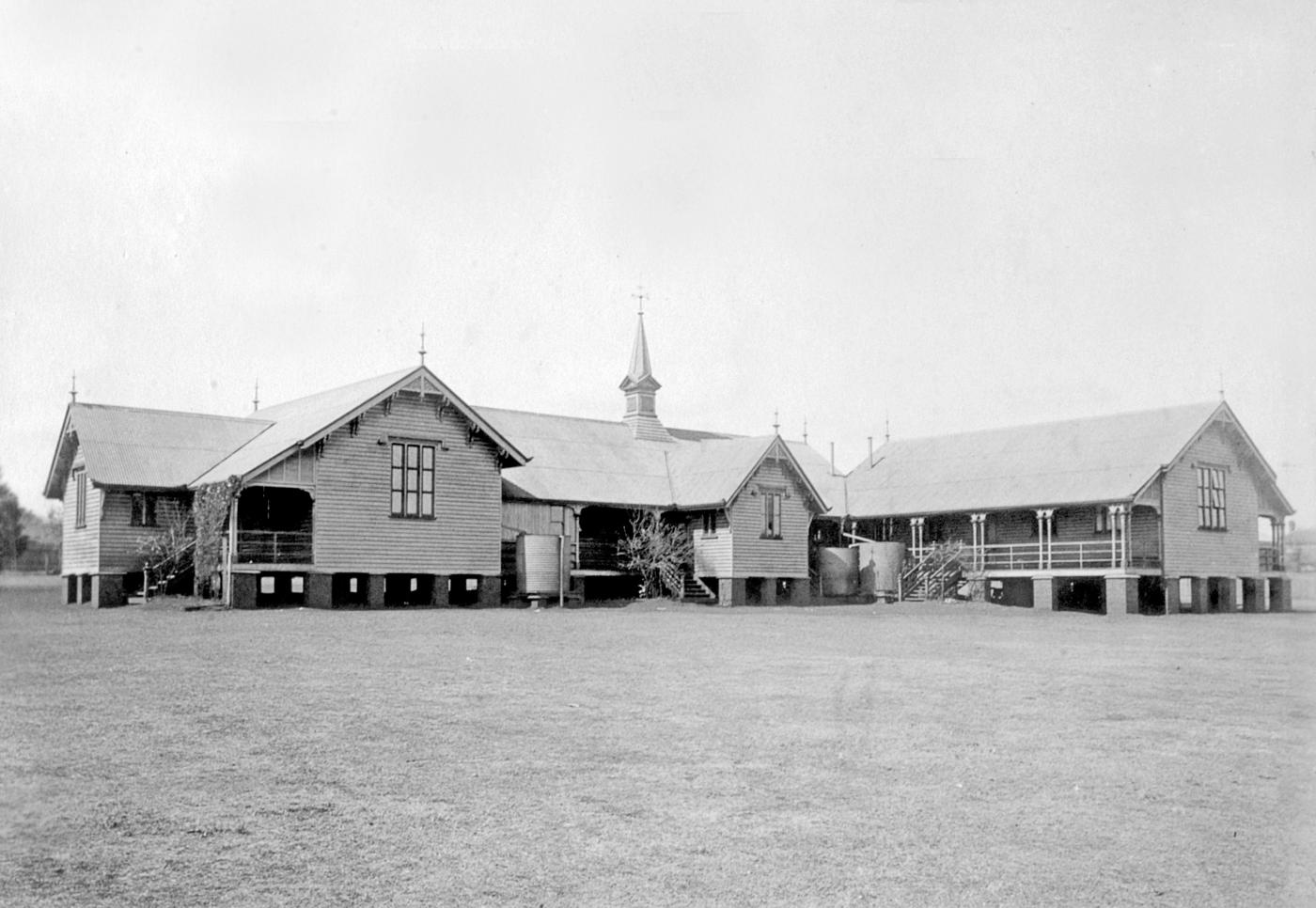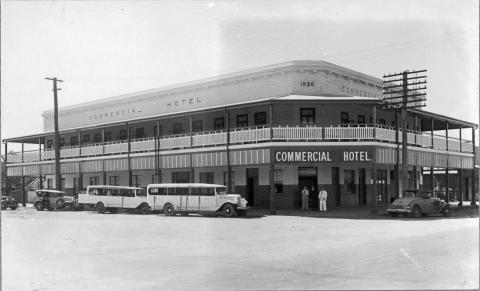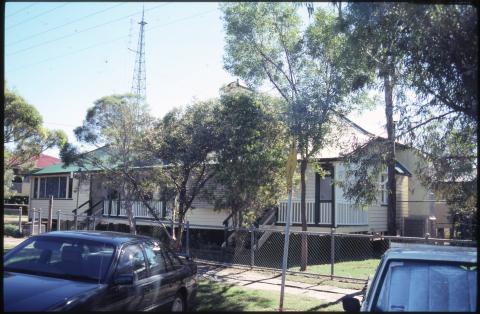
- News of the day
-
Toowoomba Chronicle and Darling Downs General Advertiser,
Tuesday 8 September 1885, page 3
Correspondence
[To Correspondents.— We do not Identify ourselves with, or hold ourselves responsible for the opinions expressed in this column.]
The East Toowoomba State School.
TO THE EDITOR OF THE CHRONICLE.
Sir,— As an old resident of East Toowoomba, it is very satisfactory indeed to find that the action of the Education Department in conditionally accepting the tender of Mr. T. Oliver for the erection of the proposed East Toowoomba State School, is more than likely to enable the School Committee to succeed in collecting the quota of local contributions needed for the fulfilment of the conditions required. How desirable it is that such success should be realised, few persons acquainted with the facts of the case will deny, and it is sincerely to be hoped that the active canvass arranged by the School Committee, will have the success it so well deserves. For the information of those of your numerous readers, Mr. Editor, who have not given this matter any thought, permit me, however, to state some of the reasons why the erection of the school under notice represents so great an advantage. Such reasons are these, viz. :- That since the juvenile population of East Toowoomba has so much increased of late years, it is urgent that school accommodation should be provided for them, and so relieve the State schools in North and South Toowoomba from the pressure which now compels many of their classes to be crowded out under sheds, and on to the verandahs of such schools. Evidence of such pressure, and its consequences, (as here stated) are to be obtained from personal observation almost any day during the time these schools are in operation. Indeed, unless such relief is soon afforded, it will become imperatively necessary to increase the accommodation of those schools by the erection of additional class rooms. To obviate such necessity, and save both children and teachers from the risk and inconvenience of their present outdoor exposure, it surely is wisest and best to assist the Committee of the proposed new school in their efforts to collect the means which will at once secure its erection, and prevent the repetition of such school-crowding for many years to come. This, Mr. Editor, will be admitted to be a very cogent reason in favor of the proposed school, but the next to which I will refer will be considered by those of your readers who regard all matters from a purely business point of view, as equally worthy of consideration. Such reason is this— That, by the collection of the £140 required to make up the fifth part of the cost of the new school, Toowoomba will be pecuniarily benefitted by nearly £1500 being thrown into local business circulation, since all, or nearly all, of the sum mentioned will be expended on the local purchase of material, and in payment of wages to local artisans and laborers. But if the local contribution is not realised, not one shilling will be so circulated in this connection. The next and final reason to be mentioned here applies particularly to those gentlemen who own land near, and contiguous to, the site of the proposed school. Such reason is this— That, by assisting to secure its immediate erection, a considerable value will be added to their property. Other reasons of nearly equal value could be advanced in favor of the subject of this letter, but fearing to trespass too much upon your space, I will conclude by stating that those of the residents of Toowoomba who have, or those who may subscribe to the fund needed for the purpose stated, need be under no apprehension that their subscriptions will fall into the same limbo which for so many past years held the funds originally collected for the same purpose. This absence of any cause for such apprehension arises from the positive fact that the Committee of the proposed school are determined not to cease from their efforts until "by hook or by crook " — as the saying goes— the purpose for which they were appointed has been carried on to an early and successful issue. Hoping, Mr. Editor, that this cause will have the benefit of your powerful support,
Yours. &c.,
PATERFAMILIAS.
Toowoomba, September 4th, 1885.
- Background
-
Toowoomba East State School (SS) opened in 1887, on its current site east of Queens Park [QHR 601607], to service the population growth in East Toowoomba at the time. The school is important in demonstrating the evolution of state education and its associated architecture. The school retains a Depression-era Brick School Building (Block A, 1936); set in landscaped grounds, with sporting facilities and mature trees. The school has been in continuous operation since its establishment.
To help ensure consistency and economy, the Queensland Government developed standard plans for its school buildings. From the 1860s until the 1960s, Queensland school buildings were predominantly timber-framed, an easy and cost-effective approach that also enabled the government to provide facilities in remote areas. Standard designs were continually refined in response to changing needs and educational philosophy and Queensland school buildings were particularly innovative in climate control, lighting, and ventilation. Standardisation produced distinctly similar schools across Queensland with complexes of typical components.
Toowoomba East SS, opened on 17 January 1887, was established on a 2.5 acre (1ha) reserve for a National School at the corner of Mary Street and Margaret Street, which had been gazetted in 1872. Although there was local pressure for a school in East Toowoomba from 1876, when fund raising by the community began, the population was not large enough to justify a state school. As a result of later population growth, the Queensland Government approved a school in East Toowoomba in October 1885. By this time the community had collected £200 of the £290 required as its one-fifth share of the £1433 construction cost, and the school was also initially referred to as Queen’s Park State School. The school consisted of a timber building set on brick piers, with two classrooms, close to the corner of Mary Street and Arthur Street. It was designed to accommodate 250 students, and had admitted 235 students by February 1887.
Growing student numbers – with 778 enrolled by 1927 – soon led to additions to Toowoomba East SS. By 1913 there were three timber buildings; a fourth (Infants) wing was added in 1928; and a fifth wing in 1932. A school residence, built in 1889, stood in the southeast corner of the reserve, fronting Mary Street; and a school bell on a stand was erected the same year.
Construction of the Depression-era Brick School Building (Block A in 2017) at Toowoomba East SS occurred during 1935-36, for a cost of £16,326.[17] The new building was sited parallel to, and facing, Arthur Street, after relocation of the old timber buildings. As the new building was only designed for 640 students, and enrolment was 1000 by the time it was officially opened on 8 May 1937 by JD Kane, the Member of the Legislative Assembly for East Toowoomba, it was necessary to retain at least four of the old timber buildings. These were relocated at a distance behind the new brick building to form a parade ground between them. The school residence was removed c1936.[18]
During the 1950s further additions were made to the school’s accommodation and grounds. In 1955, additional land was added to the west side of the school grounds, resumed from neighbouring residential allotments. Later grounds extensions, to the west and south of the original school reserve, from the 1960s onwards, meant that by 2012 the grounds covered 3.4ha. By 1956 a highset brick extension (Block B in 2017), with two classrooms had been constructed attached to the west end of the rear (south) of Block A. This building was renovated in c2016, enclosing its verandahs and demolishing the wall between verandahs and classrooms to create larger teaching areas.
Changes were also made to Block A. In 1966, the cloak room at the west end of the first floor was converted into a Health Services room. In c1974, two classrooms at the east end of the first floor of the centre wing were used as staff rooms, while another classroom was used as the principal’s office, and another was divided in half by a partition to accommodate a store room and Health Services Room. One cloak room was converted to a store room while another was a converted to a work room. In c1979, the undercroft was partially enclosed with glass louvres and doors. The northern corridors were enclosed with glazing by 1997. In c1997, the centre wing was altered in ‘upgrading’ works. This involved partitioning the northern corridors on both floors to create practical learning areas; replacing the French doors from the corridor into the classrooms with a single wide door with a half leaf; demolishing partitions between the classrooms on both floors to create two classrooms out of each set of three; and relining the ceilings with flat sheets to provide fire proofing.
Changes and additions to facilities since the 1960s have included: a school swimming pool (1966); new classroom buildings (1969-71); the removal of three of the early timber school buildings in the 1970s; a new library and a dental clinic facing Mary Street (1973); two pre-school buildings south of the swimming pool, near Margaret Street (by 1978); a Centenary Hall facing Arthur Street; covered ways south of Block A; and a new administration building north of Block A (1991). The last of the early school buildings, the 1928 Infants building (later designated the Clare Gormley Block), was demolished sometime between 2009 and 2011. In 2015, 807 students were enrolled. Students utilise sports fields in Queens Park to the west, and the Clive Berghofer Stadium to the north.
In 2017, Toowoomba East State School continues to operate from its original site, and its Depression-era Brick School Building is a local landmark. The school is important to the area as a focus for the community, and generations of students have been taught there.
Courtesy of Queensland Heritage Register
/151.9659328,-27.5598879,7/450x450@2x.png?access_token=pk.eyJ1IjoicXNhLWRpc2NvLXFsZCIsImEiOiJjamJmdTgyZXEyeWNjMnlxZm8xcmtieHgxIn0.lmT9J5tTPKGuuccQgCVSAg)



